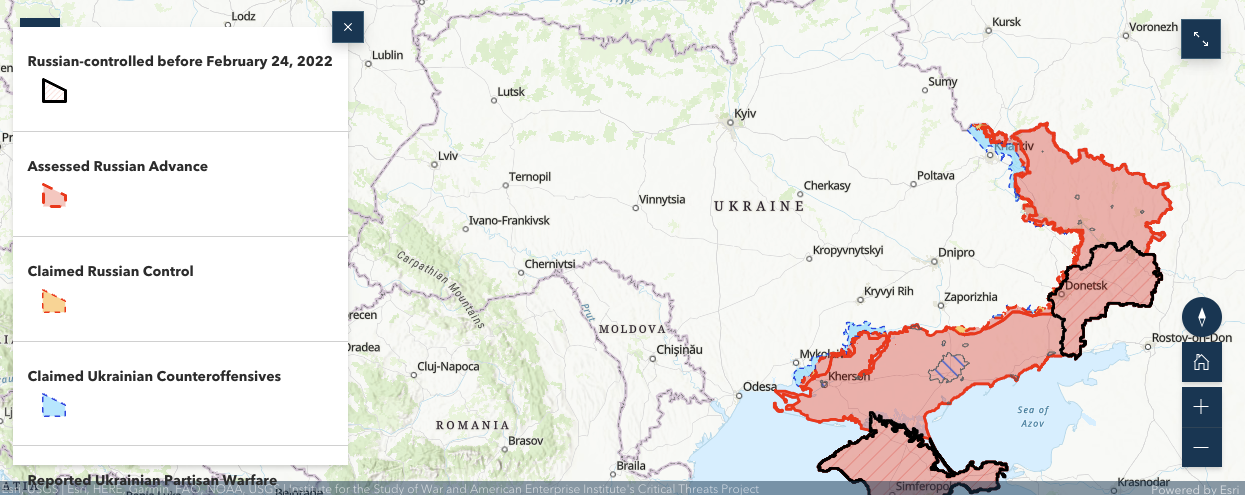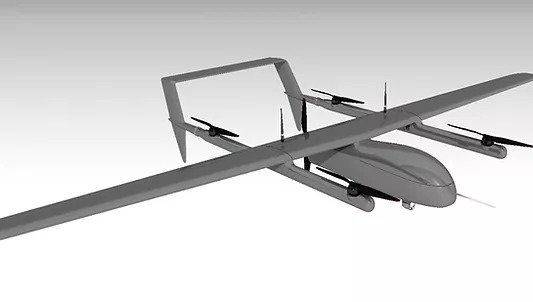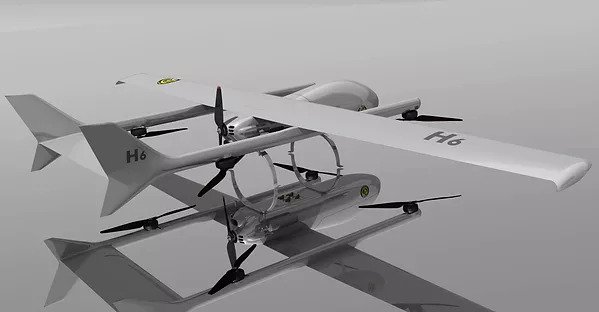The long-anticipated Ukrainian counter-offensive near Kharkiv may be underway.
Russian Telegram channels are lighting up with reports of Ukrainian attacks near the city of Balakliia in Kharkiv Oblast.
Serhiy Leshchenko, an adviser to Ukrainian President Volodymyr Zelensky’s chief of staff, said he expected Kyiv to announce “great news” about its counter-offensive in the eastern Kharkiv region on Tuesday evening, Reuters reported. He did not give further details.
The Kharkiv Oblast, in northeast Ukraine, “is on the far end of the front line from the southern Kherson region, which Ukraine last week announced as the focus of a push to retake territory.”
“Tonight there is going to be great news from President Zelenskiy on (the) counteroffensive operation in Kharkiv region,” Leshchenko said on Twitter.
Control of Balakliia could facilitate a Ukrainian attempt to encircle or partially encircle the Russian-held city of Izyum, said Kyiv-based military analyst Oleh Zhdanov, according to Reuters.
Zelensky advisor Mykhailo Podolyak hinted of things to come.
In a Tweet Monday, Sam Ramani noted that Zelensky reported that Ukraine took out a Russian warehouse containing S-300 missiles used to strike Kharkiv.
“Zelensky says that Ukraine destroyed a warehouse where Russia kept S-300 missiles to strike Kharkiv. Another win for Ukraine’s MLRS systems.”
Taras Berezovets, who claims to be a Ukrainian special forces soldier, posted a hopeful Tweet Tuesday about a Ukrainian counteroffensive near Kharkiv.
“So, Ukrainian counteroffensive near Kharkiv has begun. Keep our fingers crossed.”
When asked Tuesday about Ukraine’s attacks in the Kharkiv region, Air Force Brig. Gen. Pat Ryder, the Pentagon’s top spokesman, said he didn’t have any updates to provide. But he told reporters that Ukrainian forces in the Kherson region have “continued to make some forward movement” and that “we are aware that they have retaken some villages.”
He declined to offer further details at his briefing, deferring questions to Ukraine’s military.
And when asked why the Pentagon has been reluctant to call recent Ukrainian attacks a counter-offensive, Ryder said that too was up to the Ukrainians.
“This is a Ukrainian military operation,” he said. “We’ll leave it to the Ukrainians to characterize or define their operations in terms of where they are in their campaign. And so again, it’s not appropriate for me, as a Department of Defense spokesperson, to characterize it for them.”
But at least one outside observer was less shy about describing the attacks.
“Estonia’s cyber-command chief Kaupo Rosin predicts that Ukraine can expel Russia out of the Dnipro River right bank in 2 months,” Sam Ramani said in a tweet. “Rosin predicts the liberation of Donbas and Crimea could take months or years.”
If this offensive turns out to be as it seems, it would mean Ukraine has opened up two major offensives, one in the northeast and one in the south, aimed at unseating Russian gains.
Before heading into more of the latest news and updates from Ukraine, The War Zone readers can get caught up with our previous rolling coverage here.
The Latest
Ukraine also appears to have made progress on its southern offensive.
In its latest assessment, the U.K. Defense Ministry map does not address a specific counter-offensive near Kharkiv, but it shows Ukrainian attacks on the Russian-held Kherson Oblast and continued fighting near Kharkiv.

In addition, the latest information provided by the Institute for the Study of War (ISW) and AEI’s Critical Threats Project shows Ukraine claimed counter-offensives near Kherson as well as near Kharkiv in the east.
The Ukrainian counter-offensive “is tangibly degrading Russian logistics and administrative capabilities in occupied southern Ukraine,” according to the latest ISW assessment. “As ISW has previously reported, Ukrainian officials explicitly confirmed that Ukrainian troops seek to attrit Russian logistical capabilities in the south through precision strikes on manpower and equipment concentrations, command centers, and logistics nodes.”


For instance, Kirill Stremousov, head of the Kherson Oblast occupation regime, told Russian media outlet TASS that his administration has paused annexation referendum plans in Kherson Oblast due to “security” concerns, according to ISW.
“The Ukrainian Resistance Center similarly reported that Russian occupation authorities are abandoning plans for referenda due to the ongoing counter-offensive,” the ISW report says. “Shortly after TASS published his comment, Stremousov posted on Telegram denying he called for a pause because his administration had never set an official date for the referendum. Both of Stremousov’s statements indicate a high level of disorganization within occupation regimes that is likely being exacerbated by the effects of the counter-offensive. Ukrainian forces intend to slowly chip away at both Russian tactical and operational level capabilities in Kherson Oblast, and in doing so will likely have significant impacts on the administrative and bureaucratic capabilities of occupation officials.”
A Russian airbase at the Kherson International Airport also apparently came under Ukrainian attack.
Meanwhile, Ukraine has also struck Russian pontoon bridges in Kherson Oblast.
“According to the Southern Operational Command, Ukrainian forces attack two floating bridges near Darivka and Hola Prystan,” according to a tweet from the Kyiv Independent news organization. “All Russian pontoon bridges in the region are in firing range, the military says.”
The @NLWartracker Twitter handle goes a step further, saying the pontoon bridge attacks, as well as those on a nearby Russian warehouse, were carried out by the Ukrainian Air Force.
“Dar’iivka, #Kherson pontoon bridge GO BOOM. After attack reportedly by fighter aircraft, The pontoon bridge is no more as can be seen on these recent sat. images, also a warehouse area on the S side has been hit and can be seen burning.”
There is no proof that we know of at this time that these targets were hit by aircraft. In the recent past, HIMARS has been used to hit similar sites. Although, with the help of U.S.-supplied anti-radiation missiles, this could be changing, with the Ukrainian Air Force taking on a more significant role on and beyond the front lines.
These reported Ukrainian attacks come as more evidence is surfacing of Russia’s inability to sustain the full-scale invasion it launched Feb. 24.
On Monday, The New York Times reported that Russia is buying millions of artillery shells and rockets from North Korea.
The purchases are “a sign that global sanctions have severely restricted its supply chains and forced Moscow to turn to pariah states for military supplies.”
The disclosure “comes days after Russia received initial shipments of Iranian-made drones, some of which American officials said Russia had issues operating. U.S. government officials said Russia’s decision to turn to Iran, and now North Korea, was a sign that sanctions and export controls imposed by the United States and Europe were hurting Moscow’s ability to obtain supplies for its army.”
The report prompted Jack Watling of @Rusi.org to rethink his previous position on the state of Russian artillery shell supplies.
When asked about Russia turning to North Korea, Ryder said it’s another sign that Russia is having logistical problems.
“We do have indications that Russia has approached North Korea to request ammunition,” he told reporters Tuesday. “I’m not able to provide any more detail than that at this point in time. But it is indicative of the situation that Russia finds itself in, in terms of its logistics and sustainment capabilities as it relates to Ukraine. We assess that things are not going well on that front for Russia. So the fact that they’re reaching out to North Korea is a sign that they’re having some challenges on the sustainment front.”
The Conflict Arms Research (CAR) watchdog group recently released a report of its latest assessment of how Russia is using foreign components in its weapons systems.
“A CAR field investigation team returned to Ukraine from 12 to 16 July 2022 to document additional items and systems that Ukrainian authorities recovered from Russian forces starting in February 2022.”
These included the components of a Ka-52 helicopter, multiple cruise missiles, uncrewed aerial vehicles (UAVs), and communications and navigation equipment, all of which were manufactured in Russia.
“To date, CAR has identified a total of 144 non-Russian manufacturers of more than 650 unique component models in Russian materiel used in the war on Ukraine. Many of these items were manufactured after 2014, when the war in eastern Ukraine first began and the European Union and United States imposed an initial set of sanctions on the Russian Federation. Some items were produced as recently as 2021.”
Thus, the Russian Federation’s “ability to develop advanced weapon systems such as cruise missiles is thus highly reliant on very specific non-Russian technology.”
We covered the issue of foreign components in Russian weapons systems back in May.
And, thanks to a shortage of bearings, Russia is having trouble shipping supplies by rail, noted former Swedish Army officer Anders Tengström.
“Russian railways are grinding to a halt – why? Because they can’t replace worn out bearings on their train carriers. Why can’t they do that? Because Swedish SKF closed their factory in Tver (RU) … and the output produced was for the RU railways.”
The supply issue is so critical that Russian Prime Minister Mikhail Mishustin “signed a decree on the creation in the Russian Federation of two armored repair plants of the Ministry of Defense,” the pro-Ukrainian Ukraine Now Telegram reported Tuesday. “The deadline for putting the facilities into operation is emergency, just four months.”
And if a lack of supplies weren’t bad enough, Russian soldiers are being targeted over a lack of…affection, according to Anton Barbashin, the editorial director of Riddle Russia, an online journal of Russian affairs.
Ukrainian hackers, using “fake accounts of attractive women,” asked Russian soldiers to send their pictures. Ukrainian troops then used those pictures to geolocate the Russian troop locations and strike them with artillery fire, Barbashin noted.
While Russia is experiencing supply issues, so too is Ukraine, at least from its erstwhile German allies.
German Chancellor Olaf Scholz has blocked the sale of German weapons to Ukraine, according to the Kyiv Independent, citing the German newspaper Die Welt.
“Krauss-Maffei Wegmann (KMW) is ready to supply Ukraine with 100 Leopard 2A7 tanks and provide training sessions for soldiers worth 1.55 billion euros. Yet, according to Die Welt, Chancellor Scholz did not react to the offer.”
But other nations are less reticent about providing Ukraine with arms.
“According to VK Russian social network, Ukrainian sources report that the 26th Artillery Brigade and the 120th Reconnaissance Battalion of the Ukrainian army took delivery of Poseidon H10 and larger Poseidon H6 UAVs, the ArmyRecognition.com website reported.
The drones, manufactured by the Cypriot company Swarmly Ltd., were purchased by the charitable foundation of Serhiy Prytula” for 700,000 Euros.


Meanwhile, crowdfunding efforts are underway for Turkish drones and a Czech T-72 main battle tank.
Thanks to one crowdfunding effort, three Bayraktar TB2 drones arrived in Ukraine, according to the Ukraine Now Telegram channel. The money was collected as part of the People’s Bayraktar project, however, the manufacturer decided to transfer the drones to Ukraine for free.
So instead, the money was used to purchase a year’s access to the database of satellite images of the ICEYA constellation.
And according to the Oryx weapons tracking site, the Embassy of Ukraine in the Czech Republic “has launched a crowdfunding campaign for a T-72 Scarab” main battle tank. “The Czech MoD has guaranteed its delivery to Ukraine if enough funds are collected.”
More proof has been proffered that Ukraine is using munitions from an unlikely source – Iran.
In a Twitter thread posted Tuesday, the Ukraine Weapons Tracker handle offers more details on what it says is the use by Ukrainian artillery troops of Iranian OF-462 122mm projectiles.
Throughout the war, both sides have been innovative in turning civilian vehicles into weapons of war.
The latest example is the humble Lada Niva.
And Rob Lee posted a video “showing a Ukrainian 9A310M1 TELAR (part of the Buk-M1 system) launching a 9M38M1 SAM.”
The undated video apparently shows one of the system’s four anti-aircraft missiles being launched at a target.
The Ukrainian News 24 Twitter handle posted a video of what it claims is the destruction “of a Russian infantry fighting vehicle by Ukrainian tank at close range.”
Making matters worse for Russian troops is a lack of pay.
The Kyiv Independent, citing the U.K. Defense Ministry, noted that Russian soldiers face morale and discipline issues and often go unpaid.
“The U.K. Defense Ministry reported, in addition to combat fatigue and high casualties, Russian troops are likely experiencing “significant problems with sizable combat bonuses not being paid.”
But at least the White House is not designating Russia as a terrorist state.
“The White House confirms that Joe Biden has made a final decision to not designate Russia a state sponsor of terrorism,” Sam Ramani tweeted. “The main reason for Biden’s decision is the risk of terrorism sanctions impeding food exports and Black Sea grain export deal. Given Russia’s rhetoric about sanctions impeding grain and fertilizer shipments, a terrorism designation could give Moscow a pretext to scrap the deal.”
During its long-awaited visit to the Zaporizhzhya Nuclear Power Plant (ZNPP) last week, the International Atomic Energy Agency (IAEA) found damage from attacks and that Russian military vehicles and equipment were being stored there.
“While past events had not yet triggered a nuclear emergency, they represented a constant threat to nuclear safety and security because critical safety functions (containment of the radioactivity and cooling in particular) could be impacted,” IAEA Director General Rafael Mariano Grossi noted in the organization’s latest report on nuclear reactors in the warzone, released Tuesday.
During the IAEA Support and Assistance Mission to Zaporizhzhya (ISAMZ), “the team closely witnessed shelling in the vicinity of the ZNPP, in particular on 3 September when the team was instructed to evacuate to the ground level of the Administrative Building,” according to the report, which does not specify who launched the attacks, which each side claimed the other did.
Linda Thomas-Greenfield, U.S. Ambassador to the U.N., later reiterated her position that Russia is solely to blame for any damage to the plant.
The ISAMZ team observed damage at different locations “caused by reported events” with some of the damage being close to the reactor buildings.

The team found damage to a turbine lubrication oil tank; the roofs of various buildings such as the building for the spent fuel transporter vehicle; the special building that houses, among other items, the fresh nuclear fuel, and the solid radioactive waste storage facility; the new training building; the building where the Central Alarm Station of the physical protection system is located; and the container where the radiation monitoring system is located, in the vicinity of the dry spent fuel storage facility.
The ISAMZ team also reported first-hand observations of damage to the road surface, walls, and windows of various buildings, as well as at the overpass connecting the reactor units at the ZNPP.
“The ISAMZ noted with concern that the shelling could have impacted safety related structures, systems and components, and could have caused safety significant impacts, loss of lives and personnel injuries.”

“While the ongoing shelling has not yet triggered a nuclear emergency, it continues to represent a constant threat to nuclear safety and security with potential impact on critical safety functions that may lead to radiological consequences with great safety significance.”
In the wake of the visit, the IAEA recommended, among other things, that “shelling on site and in its vicinity should be stopped immediately to avoid any further damages to the plant and associated facilities, for the safety of the operating staff and to maintain the physical integrity to support safe and secure operation. This requires agreement by all relevant parties to the establishment of a nuclear safety and security protection zone around the ZNPP.”
The IAEA was also informed that “recent shelling had led to safety consequences and damage to plant systems and equipment, such that emergency protection was activated at one of the units, diesel generators were set in operation, and the nitrogen-oxygen station and an auxiliary building were damaged. The ongoing shelling could damage other critical plant systems and equipment, and lead to more severe consequences, including unlimited release of radioactive materials to the environment. Therefore, any shelling endangering the safety and security of the ZNPP needs to be avoided.”
The team found that there were “Russian military personnel, vehicles and equipment at various places at the ZNPP, including several military trucks on the ground floor of the Unit 1 and Unit 2 turbine halls.”
As grim as the situation is, the IAEA sees a glimmer of hope.

“Now, vitally, through the ISAMZ the IAEA has established a presence at the ZNPP which will be of paramount importance in helping to stabilize the situation. This should also enable the IAEA to monitor closely the situation at the site, and to receive direct, fast and reliable information.”
The ISAMZ experts “will carry out detailed and continuous work to assess the physical damage to the plant’s facilities, determine the functionality of the main and back-up safety and security systems, and evaluate the staff’s working conditions, in addition to performing safeguards activities on the site.”
Despite the presence of the ISAMZ team, problems apparently continue.
“BREAKING: The Ukrainian utility Energoatom reports that the final electrical line to the Zaporizhzhia nuclear power plant has been cut,” NPR editor/correspondent Geoff Brumfiel tweeted Monday.
“The last operating reactor at the site is now shut down. This is potentially the most serious situation at the plant so far.”
Concerns about the devastation that could occur at ZNPP have existed throughout this war, as we noted back in April.
We will continue to update this story until we state otherwise.
Contact the author: howard@thewarzone.com
